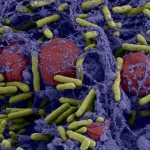Lien vers Pubmed [PMID] – 18651319
Mol. Membr. Biol. 2008 Aug;25(5):423-35
Cholesterol in the plasma membrane of eukaryotic cells contributes to modulating the functions and signalling pathways of numerous transmembrane proteins, including G protein Coupled Receptors (GPCRs). We have previously shown that the function of the human micro-opioid receptor (hMOR) expressed in Saccharomyces cerevisiae is modulated by sterols including cholesterol. Here, we investigated the effects of cholesterol content on hMOR pharmacology and on hMOR partitioning in cholesterol-poor and -rich domains in eukaryotic mammalian cells (CHO). We show that cholesterol is required for the stabilization of a receptor conformation with high agonist affinity and for triggering G-protein activation after agonist binding to the receptor. Biochemical analysis of untreated and cholesterol-depleted membranes in cells expressing hMOR indicated that the receptor is only present in cholesterol poor domains, in the basal state. After agonist binding to untreated CHO membranes, two distinct populations of receptor were found in cholesterol-rich and -poor domains. Cholesterol depletion or treatment of CHO membranes with the G-protein-decoupling agent GppNHp prevented the redistribution, indicating that receptor activated states localized into cholesterol-rich domains. Pharmacological data and biochemical analysis indicate that distinct activated conformations of hMOR exist in CHO plasma membrane and correspond to microdomains differing by thickness and proportions of lipid components, including cholesterol.

